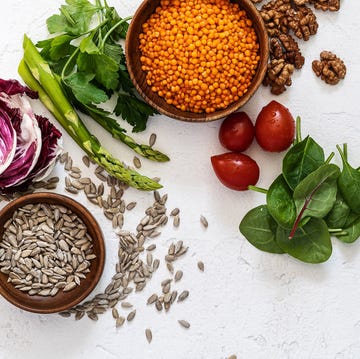We all have a vague idea of how to eat well - cut back on ultra-processed food, avoid too much red meat, don't smother everything in piles of salt - and the nation's healthy eating experts are lighting the way for the rest of us. But how do they manage challenges like sugar-loving kids, crisp-eating partners, and teenagers who snack constantly?
Chris Van Tulleken
Chris is an infectious diseases doctor, broadcaster and the author of Ultra Processed People. He lives with his wife, fashion editor Dinah, their three daughters aged eight, five and one and his mother-in-law.
"Even a couple of years ago, if you'd come to our house, I'd have shown you a huge bowl of sweets in the kitchen to stress that we’re normal and our kids eat just like other kids. But gradually, as my research became focused on food, and my broadcasting too, I started to realise that having a huge bowl of sweets in the kitchen meant our kids were eating an enormous number of them. And that sweets really are harmful for you in so many different ways. They're not actually very joyful. They don't last very long. They leave everyone feeling like crap. So while we still wrestle with it a bit, we've dramatically reduced our consumption of ultra-processed foods.
What to read next
Our other aim is to eat together - there’s lots of evidence that it’s good for you, but also it’s efficient. It means we all eat the same food, even the baby, but there’s always a compromise. Ours is usually forged through condiments. Say we’re eating chicken, rice and broccoli. The older girls can add soy sauce. Dinah and I will add pickled chilies. Everyone gets to exercise some choice, except the baby.
Cooking together helps, too - the kids are much more likely to stick whatever weird stuff they've made in their mouths than something that may be very delicious that Dinah and I have made without them. But we don't stress over having a "rainbow plate" or 35 different types of veg a week. Breakfast is very straightforward - porridge most weekday mornings, and one night a week we’re likely to have a three-ingredient meal of butter, cheese and pasta.
We don’t want the kids to feel that anything’s banned. They do know what industrially packaged, preprepared food is. They can spot a UPF but they love a pack of cheesy crisps. Joe Wicks said something really important – you have to challenge the idea that this stuff is a treat. So the girls know that kind of food is a ‘once a week thing’ but we do try to make some ‘treat foods’ ourselves – a birthday cake for example, so that they're not always associating the happiest times with the worst food.
Of course, when they go to parties or friends’ houses, they eat whatever they want. If there are cans of cola at the party, they can have them. When I'm making Operation Ouch, my BBC show for kids, I meet a lot of six- to 12-year-olds. And I know that kids do care about this stuff. If you say to an eight-year-old: ‘You can have this drink, but it will be harmful in the following ways. It will damage your teeth. The sports stars that advertise it are often not drinking it themselves. This other drink - water or milk - will be much better for you, and it will make you strong…‘ Well, often kids make good choices.
Education is important, but you have ultra-processed products in your eyeline every single minute of every day, in every office and every vending machine, even in hospitals. It’s not just hard for many families to eat well; it’s impossible. Very good data show that the households on lower incomes simply cannot afford to eat a healthy diet, and if you give people time and money, they eat well, basically. Children need to be fed differently in schools. We need to be taught differently. We need to tax things differently and have different warning labels on food. Education can protect kids a bit, but not as much as having warning labels on cans of cola would."
CHRIS’S TOP TIP: "We make a big old ragu at the beginning of the week. There'll be tomato and broccoli pasta one night, some mince added to make it into spag bol on another, and then it's cottage pie."
DINAH SAYS: "When Chris brought these ideas home the children honestly didn’t seem to care at all. I took a bit longer to get used to it. I enjoyed preprepared foods like ready-meal lasagne for a bit longer than Chris did. There were a few months where we ate different evening meals – I’d have UPF filled-pasta or baked beans. And there’s still the odd difference in our approaches. I’ll give the kids sausage and mash. Chris wouldn’t do that - it's incredibly salty processed meat. For a while, I’d sneak a packet of sugary muesli into the shopping basket, but it’s slowly shifted. I think we’ve become more sensitive to lots of the cosmetic additives - from the artificial sweeteners to the protein isolates, all the gums and emulsifiers. I feel like I can taste them in foods where I didn’t notice them before. I don’t want them any more."
Dr Saira Hameed
Saira is a consultant endocrinologist at Imperial College Healthcare NHS Trust and one of the country’s leading experts in weight-loss. The author of The Full Diet and the Full Diet Cookbook, she lives with her husband Jonathan their 14-year-old daughter, and three sons aged 13, 11 and four.
"I’ve run clinics for people living with obesity for over a decade, and I’ve learned so much from my patients – especially what makes it hard for them to stick to a healthy eating plan. So I devised a programme that didn’t rely on calorie counting and instead promotes wholefoods such as fruit, vegetables and nuts, filling up on protein, choosing foods that support gut health and reaping the benefits of healthy fats, such as dairy and olive oil.
The science supporting this way of eating is strong, so a lot of the same principles hold at home. Jonathan and I observe an eating window, choosing roughly between 1pm and 8pm most days, which boosts our health and keeps our weight steady. But the kids eat three meals a day. Our eldest are teens now, so they’re on very different schedules to the younger kids and need a lot of food and exercise.
We keep the kitchen well-stocked with easy ingredients they can cook themselves (a great way to get them interested in food and cooking) and the fridge and cupboards are full of healthy snacks like porridge oats, fruit, veg, nuts, seeds, Greek yogurt, eggs and German rye bread.
During the week, we’ll have a super-early dinner at 4.30pm or 5pm so that the kids don’t end up picking for a few hours before their evening meal. It’s about creating healthy, balanced, easy meals out of a few good ingredients that are nutritious and keep us fuller for longer. We might grab a few salmon fillets and a head of broccoli. Shake some olive oil, dried herbs, salt and pepper over the salmon and bake it in the oven. Sauté the broccoli with a bit of pesto. The salmon prep’s taken 90 seconds. The veg? Three minutes.
The same goes for breakfast: we have a massive Tupperware box in the fridge and whatever’s in the cupboard gets chucked in - porridge oats, nuts, seeds, sultanas… It makes an unprocessed DIY cereal that the kids can fix for themselves.
My teens have more autonomy and could grab sweets on the way home from school, or eat takeaway pizza at parties, but they choose not to. I think if you get out of the habit of eating junk food, then when you do eat that food you end up feeling a bit sick or headachy. It doesn’t make you want to eat it very much.
At home we sometimes have 90% chocolate - nothing fancy but a brand that doesn’t use emulsifiers. They’re the one thing I really draw a line at, because of their impact on the gut and, through that, our overall health. The same goes for artificial sweeteners. If you’re going to have something sweet, eat sugar. Generally, if you need to google an ingredient that’s a big red flag for a mega-unhealthy food, and you might want to reach for real food like strawberries instead - no googling required."
SAIRA’S TOP TIP: "Ready-diced frozen onions and cauliflower rice are huge meal prep timesavers."
JONATHAN SAYS: "I have the zeal of a convert about Saira’s eating ethos! I started in 2014 and I love the energy and overall sense of wellbeing you get. It’s great to be free from the food noise you get from processed or sugary goods and there’s a satisfying feeling of fullness after eating. It’s made food and cooking a great source of pleasure for the whole family."
Dr Federica Amati
Federica is head nutritionist at ZOE, nutrition topic lead at Imperial College London's Faculty of Medicine, and author of Every Body Should Know This: The Science Of Eating For A Lifetime of Health. She lives with her husband Paul, their two daughters, aged seven and five, and their much-loved whippet.
"I was born in Italy and raised to cook from scratch, varying your vegetables and fruit according to what’s growing locally that season. It’s just a normal way of eating there, but with my professional hat on, I also know it’s the best and simplest way to ensure you have a variety of nutritious foods in your diet that help to sustain health.
Of course, family life is all about compromises. Now that we have small children, we do buy bananas all year round. But I see a lot of really good nutritionists pour effort into disguising the most nutritious elements of food for kids. They’ll cook salmon and peas into a pancake or a fritter - fine from a nutritional perspective, but wholefood familiarity is learnt. I want the kids to see a salmon fillet and know it’s yummy, so that when they’re older, they’re equipped to make good food choices on their own.
In our kitchen, the snacks kept at their reaching level are salted popcorn, kefir, nuts and fresh whole fruit. In the fridge, there are also mini mozzarella balls -my youngest’s current favourite snack. But nothing’s banned. The kids are currently obsessed with Candy Kitten sweets. They’ll probably have one every day, but they’re kept on a top shelf out of their reach.
I have a very full-on job, so the kids often have to eat supper before I get home. I’ll ask them to sit with me at the table while I eat, and have a chat to make sure we spend time together with food.
I do buy frozen chips (check the ingredients list and pick a brand that’s just potato, salt and some vegetable oil) and I’m not averse to frozen pizza. I get one at the supermarket that’s just sourdough pizza base, tomato sauce, oregano, mozzarella and olive oil, then I chop and serve cucumber, celery, carrot, red peppers with blueberries, hummus, some cheese cubes alongside it... The kids call it a pizza feast. Starting meals with a plate of veggies, hummus, nuts and seeds is the easiest way to introduce some fibre and colour with minimal effort and minimal waste.
Another hack? Colourful sprinkles. My youngest, like all children, loves them. She has a tiny amount of them over some plain yogurt, with crushed walnuts and berries at breakfast. She feels they add joy and colour, and a quarter of a teaspoon contains far less sugar than a typical children’s flavoured yogurt.
The kids don’t love eating beans or quinoa yet. So if we’re having a pizza night, I’ll make myself a bowl of something like beans, barley, feta and sun-dried tomatoes. Everyone can dip into it if they want. But I’ve got no problem making different food for myself while still enjoying a mealtime with them.
My father passed away from colorectal cancer, and I do what I can to reduce my risk, including reducing red and processed meat consumption. But my husband and the children love eating good-quality British farmed beef around once a week, and it’s nutrient-dense for growing kids. Paul will sometimes say, ‘Do we have any crisps?’ or ‘I really fancy a biscuit…’ I haven’t banned them! We just don’t buy them in the weekly shop."
FEDERICA’S TOP TIP: "Good-quality durum wheat pasta is worth the investment. It’s a higher protein, higher fibre, higher nutrient-containing food."
PAUL SAYS: "I’d have crisps - Kettle Chips specifically - available in the house every day if it were up to me, but there’s no secrecy or sly behaviour. I’ll pop out for pie and mash with friends occasionally, but I’m 100% glad to be eating healthy food that also tastes great."















